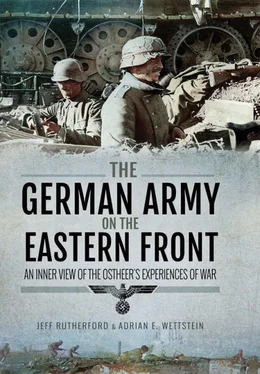The railways could only operate to a certain point behind the front, and all traffic from these railheads to the frontline or supply depots could only be carried out by vehicles. While motor vehicles could load more goods, drive faster and further, and needed fewer personnel than horse-drawn transport, the scarcity of vehicles prevented the German army from exclusively using such transportation in the supply system. The general lack of motor vehicles posed several dilemmas to the German army, beginning with production capacities and ending with the balancing of supply forces. A relatively weak automobile industry hampered production. The rearmament programs of the 1930s – including the build-up of a mechanized force and the Luftwaffe – drew both technical expertise and workers away from this industry. The production of trucks was always in competition with tanks or half-tracks and received a lower priority. The trucks that were produced were then needed for a variety of combat-related tasks: to motorize combat and support elements in the mechanized forces, to tow all kind of heavy weapons, and for the supply system. Even if the build-up of mechanized forces was limited, thereby freeing up production for trucks, there never would have been enough trucks to adequately fill the supply system. Another dilemma existed within the supply services. Based on the experiences of the western campaign and in anticipation of the vast distances and the need for the Panzer Groups’ operational freedom and flexibility to perform their decisive thrusts, the German army formed special supply columns to be used by the Panzer Groups as moving depots. While this gave the Panzer Groups a higher supply capability, it drew trucks from the regular supply columns and weakened supply possibilities for the remainder of the army, thereby widening the already existing gap between a highly effective but small spearhead and the bulk of the forces. In an attempt to at least minimize these problems, the German army desperately sought any motor vehicle available. This led to an extraction of vehicles from the German domestic sphere, as well as an extensive use of captured vehicles from the short campaigns before Barbarossa, especially those of French origin. While these vehicles added depth to German transportation capabilities, they also created new problems. These, as well as some of the issues discussed above, will be seen in the next source, a report given by the 198th Infantry Division’s staff officer for motor vehicles: [19]
I) Formation
The division was formed in November 1939 in the Protectorate as a division of the 7th wave. The vehicles were predominantly drawn from units that already had the Polish campaign behind them. […] The allocation of no all-terrain vehicles at all – with the exception of a few special vehicles for the Signal Battalion 235 – during the formation and later as well had an especially detrimental impact on the division’s previous operations. Therefore the anti-tank units and the leadership only had commercially available vehicles at their disposal. All forwarded requests in this vein remained unsuccessful.
Once again before the Eastern campaign, a request for the allocation of all-terrain passenger cars for at least the infantry and artillery regimental staffs, the artillery battalion staffs, the leaders of the anti-tank units and the staff of the Engineer Battalion 235 in view of the Eastern campaign was forcefully made to the XXXth Army Corps. Subsequently, during the campaign, the division was nonetheless allocated only 1 Kübelwagen and 5 Mercedes 170 V vehicles without four-wheel drive. The fittings for the fuel and equipment trucks were not delivered during the division’s formation, but had to be procured by the division itself on the open market, which caused severe difficulties, only increased by the division’s formation in the Protectorate.
The formation of only one permitted motor vehicle workshop platoon was carried out only by personnel with completely inadequate equipment. It was only during the western campaign that this workshop platoon with its improvised installations became fully operational. The authorized towing vehicle for towing defective motor vehicles was never attached to the workshop company.
Many divisions suffered from gaps in motor transportation right from their initial formation. The lack of heavy trucks, all-terrain vehicles and all kinds of necessary special vehicles such as half-tracks, workshop trucks, radio vehicles, properly equipped motor ambulances, and so on, can be found in nearly all divisions, including the favourably equipped Panzer and Waffen-SS Divisions. Due to the lack of adequate production, gaps had to be filled with requisitioned vehicles from the civilian economy, which had to be converted for special tasks as shown here by fuel and equipment trucks. Also common was a lack of maintenance units. This especially resulted from the contest for technically trained men, which were also needed by both industry and the Luftwaffe. Those sent to the army were mostly sent to the mobile units with their huge vehicle parks (the same being true for special equipment such as recovery vehicles, tools and machines). What was left went to the infantry divisions, and newly formed units often did not receive even enough specialist personnel for their smaller units.
II) Exchange of seized vehicles for German [vehicles]
Equipped with these vehicles, the division participated in the campaign in Denmark and France. In France, the division could replace all losses in ample manner by captured motor vehicles, with the result that the division consisted of around 75% German and 25% captured motor vehicles.
On 2. and 4.3.41, thus 8 days before the transport to the Balkans, the ordered exchange of captured motor vehicles for vehicles manufactured in Germany took place. 22 motorcycles, 40 passenger cars and 134 trucks were exchanged. This exchange had an especially harmful effect on the motor vehicle stock of the division. The division was forced to give up its whole captured motor vehicle stock, which was in very good condition, while the division it traded with – the 253rd Infantry Division, which had to exchange with 3 divisions on the whole, and which was allowed to keep special vehicles and especially urgently needed motor vehicles of German origin – could bring its most worn out vehicles to the exchange. With few exceptions, the exchanged motor vehicles, including tires, were in very bad condition.
While the division had forced up the tonnage by using captured trucks, the vehicles it received in the exchange were without exception on the lower level of their tonnage class. Due to this, the division suffered a tonnage loss of 45 tons. Immediate and repeated demands to the Special Staff Volckheim […] responsible for the exchange action, resulted in at least 22 trucks being exchanged for vehicles of a higher class of tonnage, although only used vehicles were allocated, without any possibility of choosing others. To remedy the most urgent shortage, 5 additional heavy trucks were attached to the division.
The greatest difficulty lay in the necessary reestablishment of the operational readiness of the exchanged motor vehicles, which could not be executed before the transport on 10.3. and was not set in motion before arriving in the Balkans.
In addition, a restocking of the missing vehicles within the framework of the exchange was rejected. The division had to march to the Balkans missing the following vehicles: 24 motorcycles, 13 sidecar motorcycles, 7 passenger cars, 6 trucks, 1 bus and 9 special vehicles.
The enormous booty of French motor vehicles, as well as the access to the French civil economy for production and requisition, filled the most urgent gaps in the German motor park and allowed for the expansion of the mobile units. While French booty was by far the largest, the German army also massively relied on captured vehicles from other enemies, including those found after the British retreat from Dunkirk. It is certainly debatable whether the German army would have been able to undertake Operation Barbarossa without those stocks of captured vehicles. No fewer than 84 infantry divisions, three motorized infantry divisions and even one Panzer division were primarily equipped with captured vehicles. Additionally, many of the army’s motor transportation units were outfitted with captured trucks.
Читать дальше






![John Stieber - Against the Odds - Survival on the Russian Front 1944-1945 [2nd Edition]](/books/405234/john-stieber-against-the-odds-survival-on-the-russian-front-1944-1945-2nd-edition-thumb.webp)





